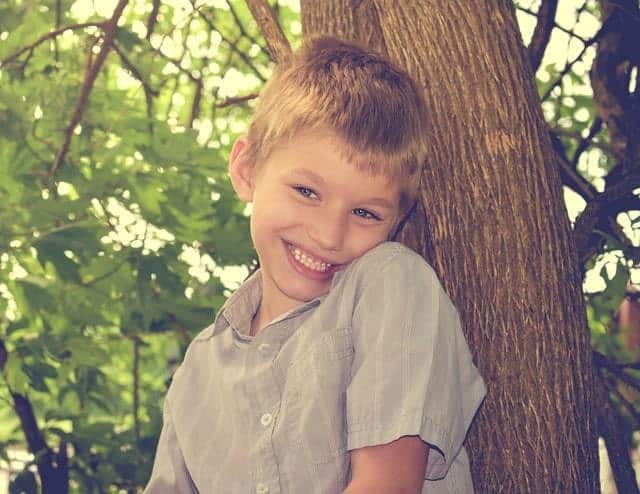Most people knows what it feels like to feel shy; that rush of blood to your face, the shaky feeling shooting through your body, the inability to find words to speak… These fearful responses are uncomfortable, to say the least, and leave a person with spirals of thoughts and feelings that can impact their social experience.
Shyness is one of those experiences that tends to get better as we get older. As we age, we become more comfortable engaging in a variety of social environments and have learned to adapt and decide how to participate in social situations based on our comfort level.
Children do not have this luxury, however; as their brains begin to develop and acclimate to their social environments, lots of kids often experience significant moments of shyness when learning how to interact with those they do not know well.
But when does shy behavior become something that may need to be treated by a mental health or medical professional?
Let’s discuss what is considered “typical” regarding shyness in children and what would be considered warning signs that your child could benefit from some professional help to improve their life!
Table of Contents
What’s Typical and What’s Not
Shy behaviors in and of themselves are not problematic; in fact, professionals consider shyness more of a personality trait than a mental health symptom in most respects.
But there is a definite distinction between typical shyness, which can be characterized as either intermittent shy behaviors or an overall shy personality trait, and social anxiety and extreme shy behavior.
Let’s talk about the differences between these types of shyness.
Typical Shyness in Children
Intermittent Shyness
Most children experience times where they feel more nervous in social situations than others. In fact, this is something that is considered developmentally appropriate for children to experience in early in life!
Early psychologists who conducted studies on attachment found that if a person has a strong attachment to at least one primary caregiver, they will experience discomfort when that trusted person leaves, and they are with people they don’t know as well[1].
The reason for this is that it takes time for babies to learn that, when their parent leaves their sight, that it is not permanent. Up until a child is about 3 years old, they have not developed the understanding of object permanence; this is the theory that babies have a hard time understanding that things out of their sight may be seen again because, in their minds, once something is out of sight it is gone forever[2].
This is why children will have upsetting responses when those they trust are not around them. Researchers call this “stranger anxiety” and note that this response usually begins at around 6 months of age and can continue until about 3 years old[3].
Common displays of this type of anxiety can look like the following[4]:
- Crying when a caregiver leaves their sight
- Clinging to a caregiver when trying to separate
- Struggles with sleep after previously developing appropriate sleep habits
Sometimes, even if a parent doesn’t leave their child’s sight, a child can exhibit some of these symptoms when around unfamiliar adults and sometimes other children as well.
This kind of stranger anxiety is usually classified as shyness, and some of the key behaviors that can result from this discomfort with meeting new people can be the following:
- Lack of eye contact when meeting someone
- Hiding behind parents or a trusted person
- Refusing to speak to someone
- Preferring to play by themselves or refusing to interact with other children, etc.
These instincts, from an evolutionary perspective, are healthy for children to have because this caution serves to protect them from possible threats from unknown people. Being wary around strangers shows that a child is working to keep themselves safe, which demonstrates development of appropriate social awareness.
Because of this protective instinct many children have, these behaviors above are considered typical so long as they are temporary in nature; if a child exhibits some of these signs of shyness at the beginning of novel experiences but is able to become more comfortable as they acclimate, this would be considered typical.
If the child cannot recover even after some time acclimating to a space with unknown people, then it may be considered more atypical and the child could benefit from some professional assistance (see Shyness Concerns That May Require Professional Assistance in Children for more info).
Shyness as a Personality Trait
As children begin to age and have more experience meeting different people, these shy instincts can disappear, and they can appear more comfortable in social situations with those they don’t know.
Other children do not seem to get over this initial hesitation completely, however, and can take a while to warm up to others or to appear comfortable in most social circumstances.
This suggests that the child’s shyness is more than just hesitation about the unknown and that it may be more related to temperament, or a part of their personality that is rather fixed. The following are what professionals consider displays of a shy personality trait[5]:
- Anxiety in social situations
- Inhibition
- Reticence, or reserved behavior (or a combination of these in social and interpersonal situations)
- Nervousness or anxiety about the evaluation by others
While these things can sound problematic, many children experience these feelings during social experiences and do not see it that way.
They may experience bouts of nerves when in the spotlight in a social or interpersonal experience, but they are able to manage their thoughts and feelings to make it through those situations without experiencing distress.
If your child does not seem to struggle with their shyness, and it doesn’t impact their ability to make and keep friendships, it is possible that they are experiencing typical levels of shyness that are characteristic of a personality trait more so than something that may need professional assistance.
Shyness Concerns That May Require Professional Assistance in Children
As mentioned above, shy behaviors are sometimes outgrown as children age, but sometimes stick around in ways that do not cause a problem for a child’s social or educational functioning. Sometimes, however, a child may experience a decrease in their functioning that requires professional help.
While the term “shyness” is meant to describe a personality trait that is not itself problematic, those who experience severe social anxiety may also appear to engage in behaviors associated with shyness, which can be confusing for parents who are unsure of whether or not their child needs help.
While it’s true that many children, teens, and adults who experience social anxiety disorder (SAD) may not consider themselves shy, shyness is a common co-occurrence with social anxiety disorder.
Overall, professionals suggest that shyness, like many other behavioral or personality quirks, may be a spectrum; children can have normal levels of shyness that do not disrupt their lives, but further across the spectrum another child may experience severe symptoms that overlap with mental health disorders like SAD.
Here are the symptoms of SAD that would differentiate from shyness and suggest that your child may need treatment[6]:
- A persistent fear of one or more social or performance situations in which the person is exposed to unfamiliar people or to possible scrutiny by others
- The individual fears that he or she will act in a way that will be embarrassing and humiliating
- Exposure to the feared situation almost invariably provokes anxiety, which may take the form of a situationally bound or situationally pre-disposed Panic Attack
- The person recognizes that this fear is unreasonable or excessive
- The feared situations are avoided or else are endured with intense anxiety and distress
- The avoidance, anxious anticipation, or distress in the feared social or performance situation(s) interferes significantly with the person’s normal routine, occupational (academic) functioning, or social activities or relationships, or there is marked distress about having the phobia
- The fear, anxiety, or avoidance is persistent, typically lasting 6 or more months
- The fear or avoidance is not due to direct physiological effects of a substance (e.g., drugs, medications) or a general medical condition not better accounted for by another mental disorder
The main distinction between shyness and a mental health disorder like SAD is that a child experiencing symptoms of severe anxiety will be showing signs of physical and emotional pain in social situations, causing them to avoid socialization and activities that they may really want to participate in.
It is common for children to identify experiencing physical characteristics (stomach aches, headaches, other signs of illness) directly connected to a social experience.
For example, if a child is experiencing severe social anxiety regarding participating in an after-school sport, it is not uncommon for them to express feeling sick to their stomachs and even vomiting if their anxiety is severe enough.
These reactions can cause them to avoid the activity in an effort to manage their anxiety, thus decreasing their ability to participate in desired activities and to find opportunities to socialize.
Typical Shyness in Teens
Long-Term Shyness (Personality Trait)
As mentioned above, shyness can be something that children grow out of, but it can also be something that becomes a more fixed personality trait that stays with them throughout their teenage years and possibly into their adulthood.
Shyness from the personality trait perspective is not something that is considered a mental health condition but can have some impacts on their socialization. Teens who are more shy than others can be ostracized by their peers, as others may see their shyness as lack of confidence, awkwardness, or can make them seem unengaging or uninteresting.
Even teens with minimal levels of shyness can be categorized by others as being extremely shy when that may not be the case at all. This is why, while shyness is a normal and typical personality trait, it can often be misconceived by others in teen years. Here are some of the behaviors categorized with typical, personality-based shyness:
- Taking a while to warm up to people
- Staying silent in discussions or social interactions
- Avoiding eye contact
- Introverted non-verbal body behavior (hanging head, shrunken body language, wearing a hoodie to shield self from others, etc.)
- Avoiding social interaction in general (sitting alone at lunch, refusing social invitations, etc.)
Shyness Beginning in Teen Years
While there are many children who have shy personalities from birth, some teens who were once confident and outgoing kids can become insecure, shy, and nervous in their teenage years. This results from the many hormonal and social changes that happen during teenage years that make adolescents feel vulnerable and self-conscious.
Developmental psychologists discuss that teenage brains are fixated on figuring out how they fit into their social world, and often have a hyper focused belief that they are being heavily scrutinized by those around them at all times.
This is why teens seem more easily embarrassed about things that they may not have worried about as children; the typical example is teens wanting to be dropped off away from school or a social event, so they aren’t seen driving with their parents.
Teens have what developmental psychologist David Elkind called “adolescent egocentrism”, where they feel as if they are personally unique and no one else could understand them or their circumstances, particularly socially[7].
Because of this, they often feel that they are (or should be) the constant focus of the attention of those around them, developing the mentality that others are constantly focusing attention on them and scrutinizing their behaviors, appearance, etc.
They feel like they are continually the central topic of interest to a group of spectators (their peers, in particular) when this isn’t, in fact, the case at all because their peers are all thinking the same things about themselves!
Psychologists call this the “imaginary audience” theory and discuss how this relates directly to some of the emotional volatility that teens have relating to feeling self-conscious and misunderstood[8].
While this is typical and a normal part of adolescent development, it can impact their social growth, thus becoming problematic. If your child is able to keep and maintain friends and does not seem isolated or lonely, these patterns of behavior may not be impacting them enough to suggest that they need assistance.
If you are noticing that your child is isolating, has fewer friends than in childhood, or seems generally lonely or unhappy with their social life, this may be an indication that they need some assistance with their shy behaviors. (see Shyness Concerns That May Require Professional Assistance in Teens for more info).
Shyness Concerns That May Require Professional Assistance in Teens
Just like with children, shyness is only a problem when it impacts their social, emotional, physical, or educational functioning. If a teen is able to feel confident and comfortable in social environments, even if it is not what they prefer, they may not need any help fixing these parts of their personality.
If they are struggling to fit in or find their way in social or academic settings, however, and seem distressed or extremely uncomfortable, this may require some help from a professional who can help them keep the positive qualities that come with being shy but help them to grow and feel self-confident as well.
All of the symptoms of Social Anxiety Disorder mentioned above (see Shyness Concerns That May Require Professional Assistance in Children for more info) are also symptoms that relate to teens as well and would be indicators that your teen may need help from a professional.
In addition to these things, however, there are some other indicators that your teen is not just experiencing typical shyness but may have other symptoms of distress forming under the guise of being shy. Here are some of the red flags to look out for that may indicate that your teen needs some professional help:
- Loss of interest in socializing with peers
- Decreased amount of contact with friends
- Loss of friendships and/or inability to make or keep new friends
- Isolative behavior, not wanting to participate in previously enjoyed social experiences or activities
- Persistent and extreme negative statements about their appearance and intense scrutiny about their body, clothes, and interests.
- While this is normal in some degrees with teens, if it seems excessive, it may be something that they should address with a professional.
- Teacher reports that they are disengaged and not participating in class, thus impacting their grades
- Significant anxiety around having attention drawn to them, and worrying that others are constantly scrutinizing them
- Again, this is relatively normal at this age, but if a teen is experiencing symptoms of anxiety or panic regarding these things, getting them help could be beneficial.
How Can I Help My Child?
Knowing the difference between typical shyness and social anxiety is the most important way that parents can help their children.
If a child’s shy behavior seems to be impacting their ability to have positive experiences in social activities or family events, or if your child seems to be sad, lonely, or isolated, these are cues that something more serious may be happening and they could benefit from some professional help.
Aside from getting professional help when it’s necessary, parents can help their children by assuring that their schedule allows time for social opportunities and activities, helping to arrange play dates and time in extra-curriculars that help them socialize, even if they are hesitant to do so at first.
Maintaining communication with children about their friendships and their feelings of belongingness in school can also help them to come to you if they are struggling with issues that have caused them to develop shyness.
In addition to this, helping your child maintain a positive self-image is important in helping them develop the confidence to overcome shyness if it is impacting their life. Using labeled praises that show their positive qualities (“You are so creative!” “I love how caring you are,” “You tell the best jokes!”, etc.) is a great way to help kids begin to internalize positive messages about themselves.
Sometimes the most effective way that a parent can help a child who is shy or socially anxious is to normalize that socializing can be a nerve-wracking experience! Discussing the times you have felt shy and things you have told yourself to overcome your shyness can often help your child feel less alone and feel more confident that they can overcome their fears in social settings.
What Can I Expect in the Future?
If you’ve gotten this far, you now know that shyness is usually a relatively normal pattern of behavior that many kids can grow out of. This means that it’s possible that your child will grow out of their hesitations and shyness in social situations!
While this is common, it is always a good idea to monitor your child’s behavior and personality to determine if they are on the other side of the shy spectrum and are at risk of developing a severe anxiety disorder that can impact their life. If your child is experiencing significant anxiety, early intervention is key to helping improve their ability to conquer their fears, to feel confident in social situations, and to be happy with themselves in all settings.
Having a mental health professional there to help them understand how to re-think their fears and how to react to negative social situations will help to improve their ability to look and feel more confident.
If they don’t get this help, they are at risk of not only isolating and experiencing symptoms of anxiety or depression when they feel like they do not fit in, but their shyness can also impact their socialization by causing others to not be interested in interacting with them either, only compacting the problem.
What to Expect When Seeking Help
Social anxiety and extreme shyness can diminish a child’s ability to grow and thrive, and addressing these issues early is of primary concern when they are noticed. The traditional approach for helping children with anxiety involves cognitive behavioral therapy (CBT).
Mental health professionals often use CBT strategies to help children and teens experiencing extreme shyness by helping them understand how their thoughts about social situations affect how they feel, and how they feel affects their social behavior.
In this understanding, professionals can help a child understand how a lot of the thoughts they have come from faulty assumptions or negative automatic thoughts with no evidence that they are accurate or true. Helping them understand this can cause them to realize that if they control the way they’re thinking about socialization, it can help them feel better and respond better in social situations.
These professionals can also help a person develop coping skills if they are experiencing panic symptoms or other more serious symptoms of anxiety or depression as a result of their social fears. In addition to this, if anxiety is extreme, medication support may be implemented to help the child to use coping skills discussed in treatment, as well.
In addition to CBT, it could be beneficial for a child to participate in social skills treatment programs to help them learn the best ways to succeed in their social world. Mental health professionals who specialize in social skills usually conduct group therapy where a child can practice social engagement and therapists are there to help redirect them to use appropriate social skills.
This often involves playing or communicating in ways similar to their school social environments and helps them to identify the positive ways to interact in those settings to set them up for success.
Professionals who conduct social skills treatment programs are often also trained in CBT strategies and could provide a combination of individual therapy and group therapy to help a child overcome their anxiety, or they can collaborate with other professionals to help integrate social skills into any other treatment the child is receiving.
It is important to recognize that having a shy child usually means you have a child that is careful, caring, empathetic, thoughtful, and socially aware, and these things are important positive qualities for a child to have! Nevertheless, watching your child look and feel uncomfortable or anxious in social environments can be overwhelming and devastating.
Hopefully this has helped you to tease out where your child is currently residing on the shyness spectrum and whether or not they could benefit from some extra help. Extreme shyness and social anxiety is definitely something that can be treated and overcome to help your child have a happy and full social life.
Resources
- Ainsworth, M. D. & Bell, S. M. (1970), Attachment, exploration, and separation: Illustrated by the behavior of one-year-olds in a strange situation. Child Development, 41:49-67
- Piaget, Jean (1977). Gruber, Howard E.; Vonèche, J. Jacques. (eds.). The essential Piaget. London: Routledge and K. Paul.
- Brooker, R. J., Buss, K. A., Lemery-Chalfant, K., Aksan, N., Davidson, R. J., & Goldsmith, H. H. (2013, November). The development of stranger fear in infancy and toddlerhood: normative development, individual differences, antecedents, and outcomes.
- (n.d.). default – Stanford Children’s Health.
- Shyness… Or Social Anxiety Disorder?
- American Psychiatric Association. (2013). Social Anxiety Disorder. In Diagnostic and statistical manual of mental disorders (5th ed.). Washington, DC: Author.
- (n.d.). APA Dictionary of Psychology.
- (n.d.). APA Dictionary of Psychology.







